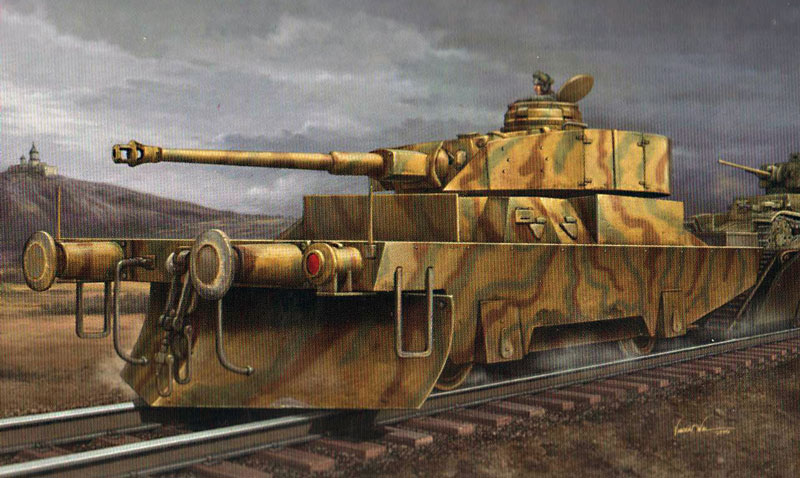
One of the non-motorised Panzerjägerwagen of PZ 3
[Panzerzug 3]. They were not equipped with Schürzen nor hull up-armouring. On
the left is the tank-transporter wagon. This arrangement of these two wagons
back-to-back is very unusual.
The Panzerjägerwagen is the surest way to identify a
Panzerzug BP 44 (and earlier trains brought up to that standard). Designed by
the LHW Company, this wagon had a 5m (16ft 4¾in) wheelbase. Sloping armour
protected the sides and the axle boxes, while a stoneguard in the shape of a
snowplough was fixed to the front end. This wagon could propel itself
independently at modest speed thanks to four rollers placed in front of the
rail wheels. The coupling system was mixed: standard at the front and
Scharfenberg at the rear.
The turret from a PzKpfw IV Ausf H, armed with a 7.5cm KwK40 L/48 was mounted on a well-shaped casemate, provided with firing and observation ports; in general the turret and casemate would have had additional external armour plates fitted.
Two PanzerJägerWagen preceded by a Croat wagon.
Combat experience quickly showed that the four 76.2mm or
10.5cm calibre guns were incapable of successfully engaging Russian tanks, and
an expedient resorted to at the front was the mounting of the hull of a tank
(PzKpfw IV or T-34) in order to use its turret armament. In parallel, a design
study initiated by L-H-W resulted in the construction of a ‘Panzerjägerwagen’
(tank destroyer wagon) in 1944, equipped with the turret of a PzKpfw IV armed
with a 7.5cm L/48 gun. On 6 September 1944 the Army High Command ordered the
construction of 12 PZ of a new type to be designated BP 44, which complied with
these latest standards. In parallel with the coupling of two Panzerjägerwagen
at each end of the train, the 10.5cm guns were replaced with 15cm le FH 18
howitzers.
In use, the BP 42 and BP 44, which represented the high
point of the art, proved themselves highly efficient at maintaining the morale
of troops fighting bands of partisans, but suffered from the weaknesses due to
their conservative design: steam power, their extreme length, lack of
flexibility and limited armour protection. As a result, in August 1944 a
front-line officer proposed an armoured train comprising a diesel locomotive
coupled in the centre of two heavily-armoured wagons and six Panzerjägerwagen.
Trains were made up of a rake of these trolleys as follows:
two sets of five trolleys (le.SP built by Steyr) or eleven trolleys (s.Sp also
built by Steyr), alternating armed trolleys, command trolleys with radio
antenna and trolleys with a tank turret. The train thus arranged was completed
at each end by a Panzerjägerwagen slightly different to those used with the BP 42
and BP 44 type trains.
The organisation of the Eisb.Panz.Zg (le.Sp) was laid down in K.St.N. 1170P dated 1 October 1943, that of the Eisb.Panz.Zg (s.Sp) in K.St.N. 1170x dated 1 August 1944, that of the Pz. Triebwagen Littorina by K.St.N. 1170i dated 10 April 1944, and finally that for the Pz. Triebwagen ‘a’ and the Panzerjäger Triebwagen by K.St.N. 1170a dated 1 January 1945.